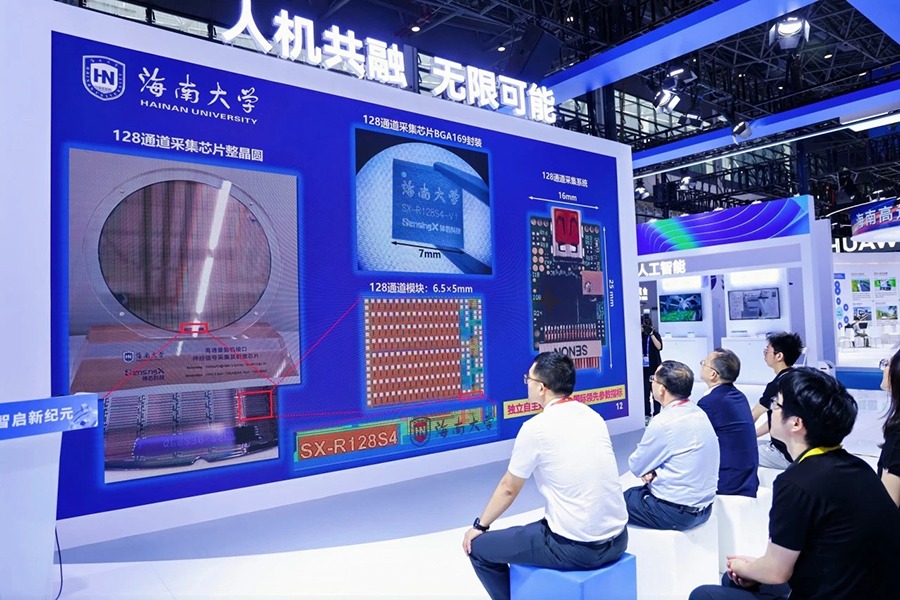Brain-computer interface wired for the future


Once relegated to the realm of science fiction, brain-computer interface (BCI) technology is now emerging from the lab and entering hospitals, with Beijing footing the bill this time.
On April 10, it was announced that the first clinical and translational ward for BCI in China has been inaugurated at Tianjin Huanhu Hospital, affiliated with Tianjin University.
On March 12, China's National Healthcare Security Administration issued its first-ever pricing guideline for cutting-edge medical services, singling out BCI as a standalone project. The move is a milestone: a made-in-China pricing blueprint specifically designed for one of the most audacious technologies.
BCIs are systems like no other. They don't just beep or buzz; they build a bridge between mind and machine. For people living with paralysis, BCIs offer hope of movement; for those who cannot speak, a chance to speak; for the blind, a hope to see some light. The new policy paves a financial fast lane from the lab to the hospital, showing the government's intent to turn miracles into tools of mass healthcare.
What sets BCI apart from other human-machine interactions is that it skips the middleman. While your fingers fumble with screens, BCIs decode your very thoughts — those tiny sparks of neurons firing in the grey matter — and translate them into digital commands. No voice. No movement. Just raw cognition converted into action. It's like telepathy meets engineering.
There are two main types of BCIs: invasive, which implant electrodes into the brain (think sci-fi with surgical gloves), and non-invasive, which simply read neural activity through scalp-mounted sensors (more like "eavesdropping" on your brain rather than hacking it). Chinese researchers are currently leading in the latter.
The Brain-Machine Interaction and Human-Machine Fusion Haihe Laboratory is leading the research into noninvasive brain-computer interfaces, focusing on key applications in physical medicine, rehabilitation, aerospace medicine and ergonomics. Its work ranges from microlevel mechanisms to large-scale engineering solutions, achieving groundbreaking results that place it among global leaders in the field.
Their "Shengong" series of BCIs, names that sound like martial arts moves, covers everything, from hydrocephalus diagnosis to cochlear assessments. If "Iron Man" had a rehab facility, this would be it. In February this year, the lab, together with Tsinghua University, published a dual-loop BCI system in nature electronics, putting China firmly on the map of next-gen neurotechnology.
BCIs' commercial future comes down to two tracks: smart healthcare and consumer electronics. The first is already here. From real-time epilepsy diagnostics to Parkinson's monitoring, BCIs are reshaping how we understand and treat neurological disorders. Paired with prosthetics, they can help rebuild limb function; paired with rehab tools, they can speed up recovery. But to scale this up, developers need to balance clinical benefit with cost-effectiveness, and convince hospitals, not just sci-fi fans, about its effectiveness.
The second track is, well, a little flashier. Consumer BCIs promise to reinvent how we interact with devices. Imagine using your thoughts to unlock your phone or control smart appliances.
Short term? Long term? Think fully immersive metaverses, personalized education based on brainwave feedback, or games where your "avatar" leaps when you just "imagine" it.
BCIs could also reshape daily life: smart homes controlled by thought, astronauts operating equipment with their minds, or workers managing machines remotely. In education, real-time brainwave feedback could support personalized learning and help overcome attention issues.
But before all that, the tech needs a glow-up — smaller, cheaper, more stable, and less like a swim cap wired to a toaster. As usual with new tech, the hardest part isn't the invention — it's the adoption. BCIs still face the "last mile" dilemma. In healthcare, accuracy and stability remain major hurdles. In the consumer realm, comfort and aesthetics matter more than ever. The technology may work, but will it fit into people's lives? Can it be safe?
Policymakers, on their part, need to play catch-up. Until now, the lack of a reimbursement category meant most patients were priced out. China's new policy doesn't bring in just clarity; it also brings in hope. It tells patients that this tech isn't just experimental; it's essential. It tells innovators that your inventions have a place in our healthcare system.
Crucially, the NHSA guideline also promotes price transparency, helping prevent both under- and over-treatment, and respects the diversity of BCI applications, allowing tailored service models.
Yet BCI is not just an engineering issue. It's a social issue. We need ethics. We need public trust. We need to ensure such technologies don't become playgrounds for dystopian fantasies or clickbait headlines. More important, the media should resist the urge to oversell and oversimplify, and scientists must come forward to explain the implications. Which means educating the public, setting boundaries, and guarding against overhyping. If BCI is to become as common as smartphones, it must evolve from being "invasive" to being "invisible", and eventually "intuitive". That's a journey not just of wires and codes, but of policy, patience and purpose.
China's move to integrate BCI into its medical payment system is a signal to the world that it is not just talking about the future, but underwriting it.
The author is vice-president of Tianjin University and a member of the National Committee of the Chinese People's Political Consultative Conference.
The views don't necessarily reflect those of China Daily.
If you have a specific expertise, or would like to share your thought about our stories, then send us your writings at opinion@chinadaily.com.cn, and comment@chinadaily.com.cn.


































